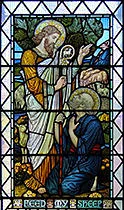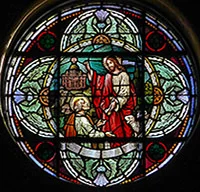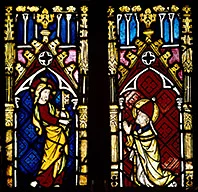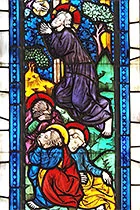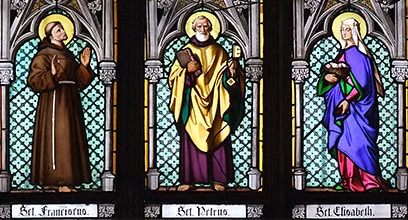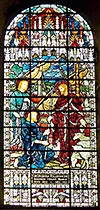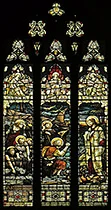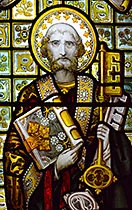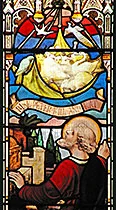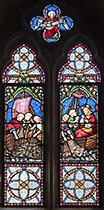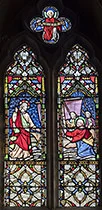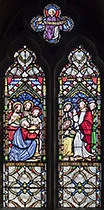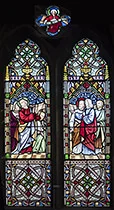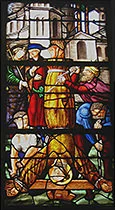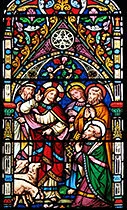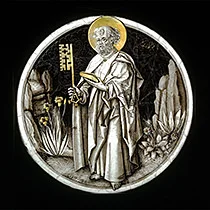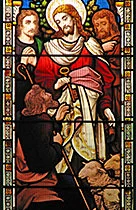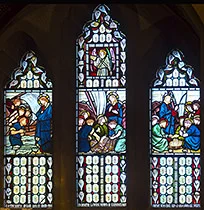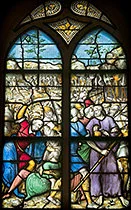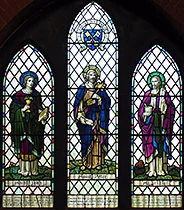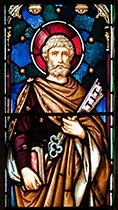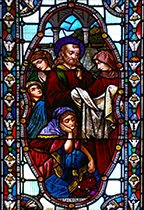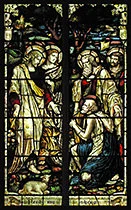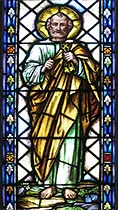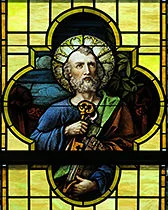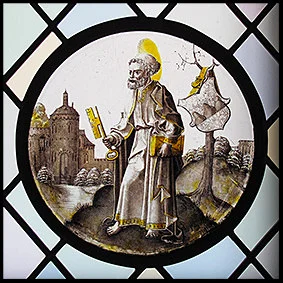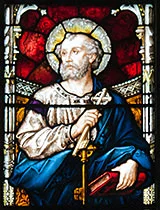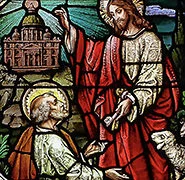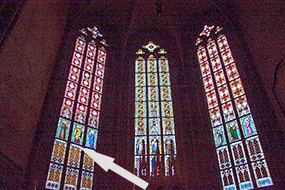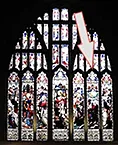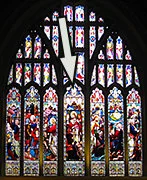The Art World Commemorates Peter
Stained Glass Artwork — Album 17
In addition to the 550 famous “Peter” works of art (paintings, frescoes, etchings, sculptures, and engravings), Warren Camp also presents these thirty-four unique, stained glass creations from the 13th century to the early 20th century.
Whether depicting “Cephas,” “Petrus,” “Simon,” “Simeon,” “Simon Bar-Jonah,” “Simon Peter,” “The Rock,” “Peter,” “Apostle Peter,” or “Saint Peter,” each stained glass enlargement of this acclaimed Bible figure comes with factual and enlightening details: the window designer and/or artist; when each work was created; where it can be seen; applicable Bible passages; background and highlights of each work; and photo sources with copyright notices.
To realize and appreciate the impact that Peter had on numerous art-world masters, be sure to click each thumbnail to enlarge it!
• This photo album complements Warren Camp’s Bible-study commentaries that he’s written for “1st and 2nd Peter” found here.
Stained Glass Windows of Saint Peter
of Heaven to Saint Peter”
Slide 7
Click to enlarge.
Cathedral of St John
the Evangelist,
Louisiana, US
Slide 11 — Click to enlarge and read the detailed caption.
undated
Saint Vitus Cathedral, Chapel of John the Baptist
Prague, Czech Republic
Draught of Fishes”
Slide 14
Click to enlarge.
c. 1901–1902
St Martin’s Cathedral
Leicester, England
Animals to Eat”
Slide 16
Click to enlarge.
1878
Church of St Peter
Nottingham, England
“Miraculous Catch of Fish”
Slide 17
Click to enlarge.
1857
St Peter’s Church
Bournemouth, England
“Peter Sinking in Lake”
Slide 18
Click to enlarge.
1853
St Peter’s Church
Bournemouth, England
“Peter and the Keys”
Slide 19
Click to enlarge.
1853
St Peter’s Church
Bournemouth, England
“Peter Denies Christ”
Slide 20
Click to enlarge.
1852
St Peter’s Church
Bournemouth, England
Slide 22
Click to enlarge.
Possibly 1866
Mary de Castro Church
Leicester, England
Slide 25
Click to enlarge.
1864
St Peter’s Church
Bournemouth, England
Slide 27
Click to enlarge.
c. 1930
St Martin’s Church
West Acton, London
Slide 28
Click to enlarge.
undated
St Aidan’s Cathedral
County Wexford, Ireland
- 1. “Saint Peter,” small stained glass, unknown artist/maker, 1400–1450
This small Saint Peter tracery light (an upper opening of a larger stained glass window) is on display at V&A South Kensington, London. “In this panel, Saint Peter holds keys, which are his identifying symbol. In the gospel of Saint Matthew (16:18–19), Christ gave Peter the ‘keys to the kingdom of heaven.’ Haloed Peter also bears a scroll above him with Latin words meaning: ‘I believe in God the Father almighty.’ Incidentally, this is the first line from the ‘Apostles’ Creed,’ a statement of faith in the Christian church. A very early tradition maintains that the apostles gathered together after the ascension of Christ and the Holy Spirit inspired them to write the Apostles’ Creed, each contributing a line [as highlighted in this c. 1300 illuminated manuscript].”[1]
Note: The Apostles’ Creed (“the oldest creed of the Christian church; in its oldest form, it goes back to at least AD 140.”[2]) is a good summary of Christine doctrine. However, the Apostles’ Creed is not found in the Bible. Also, the Apostles’ Creed was not written by the apostles. Rather, it was written at least 150 years after all the apostles had died. It’s called the Apostles’ Creed because it’s supposed to be a record of what the apostles taught. You can read and recite the apostles’ summary of Christian doctrine.[3]
… Height: 20 in. (50.7 cm), width: 7 2/3 in. (19.4 cm)
… Photo source, license, attribution, church or museum details, and image enlargement: V&A South Kensington, London
Return to “Peter Masterpieces” album’s opening page or to the top of this page. - 2. “Saint Peter Preaching,” painted stained glass, painted by Arnold of Nijmegen, c.1525–1530
This is the first presentation of three stained glass windows in Warren Camp’s “Peter Masterpieces” stained glass Album 17, all of which were painted by Arnold of Nijmegen. The same scenes are depicted in glass from Saint-Vincent in Rouen (now in Sainte-Jeanne-d'Arc, Rouen) and in Notre-Dame du Grand-Andely, Les Andelys.
“Arnold of Nijmegen was a 15th-century Dutch stained glass artist who worked in both modern-day Belgium and France, adopting the Renaissance style and influencing the stained glass workshops of Normandy. His work is known for its delicate draftsmanship, brilliance of coloring, rich decoration of robes, and detailed architectural settings. The Victoria and Albert Museum has three panels depicting scenes from the life of Saint Peter; the panels are sections of a window from a church in Rouen, France.”[1]
In this window panel titled Saint Peter Preaching, the artist presents a scene “before Christ ascended to heaven, when he instructed his disciples to spread his teachings around the world (the Great Commission, Matthew 28:16–20). Herein, Peter is shown preaching about the life, death, and resurrection of Christ. Peter, wearing a red gown and a blue cloak, preaches to a crowd from a pulpit. One of the crowd, an elderly man, holds his hands in a praying position, indicating that he has been converted to the teachings of Christ.”[2]
… Height: 59 1/4 in. (150.5 cm), width: 24 1/8 in. (61.4 cm)
… Photo source, license, attribution, church or museum details, and image enlargement: V&A South Kensington, London
Return to “Peter Masterpieces” album’s opening page or to the top of this page. - 3. “The Martyrdom of Saint Peter,” painted stained glass, painted by Arnold of Nijmegen, c.1525–1530
The Martyrdom of Saint Peter This is Warren Camp’s second presentation of three stained glass windows painted by Arnold of Nijmegen in this “Peter Masterpieces” Album 17.
“During his lifetime, Christ named Peter as a leader of his apostles; thus, he was seen as the foundation stone (Latin: petra) of the church. Peter traveled to Rome on at least two occasions to spread the word of Christ. The earliest known account describing his death dates from the end of the 2nd century. In this window panel, Peter is shown being crucified upside down on a cross. Crucifixion was a common form of execution for non-Roman citizens, and tradition says that Peter refused to be crucified in the same manner as Christ.”[1] The Scriptures don’t record the date, location, or specific type of Peter’s death. It’s traditionally recognized that he suffered martyrdom by crucifixion, in Rome, during Nero’s time, possibly AD 64 to 67.
“Arnold of Nijmegen was a 15th-century Dutch stained glass artist who worked in both modern-day Belgium and France, adopting the Renaissance style and influencing the stained glass workshops of Normandy. His work is known for its delicate draftsmanship, brilliance of coloring, rich decoration of robes, and detailed architectural settings. The Victoria and Albert Museum has three panels depicting scenes from the life of Saint Peter; the panels are sections of a window from a church in Rouen, France.”[2]
… Height: 59 1/3 in. (150.6 cm), width: 24.5 in. (62.2 cm)
… Photo source, license, attribution, church or museum details, and image enlargement: V&A South Kensington, London
Return to “Peter Masterpieces” album’s opening page or to the top of this page. - 4. “Christ Appears to Saint Peter after Resurrection,” stained glass window, painted by Arnold of Nijmegen, c.1525–1530
This is the third of three Arnold of Nijmegen (Arnoult de Nimègue) stained glass panels in this “Peter Masterpieces” Album 17. All three were made with clear and colored glass with painted details and silver stain. In this Christ Appears to Saint Peter after the Resurrection panel, “Christ appears to Saint Peter after the Lord Jesus’ resurrection. From the now-ruined church of Saint-Pierre-du-Châtel in Rouen, Normandy, this and the other two Arnold of Nijmegen (Arnoult de Nimègue) panels are on view at V&A South Kensington, London.
“Christ, wearing a red robe with white and gold trim, and a rich gold-brocaded inner lining, stands on the left of the panel. He holds a long cross as he blesses Saint Peter with his right hand. Peter, attired in a red gown with a blue cloak, kneels outside the empty tomb with his hands held in prayer while gazing up toward Christ’s face. The Lord’s wounds are not visible. Above his halo, a castle is depicted in the panel’s top-left corner.”[1]
The painter, “Arnold of Nijmegen, was a 15th-century Dutch stained glass artist who worked in both modern-day Belgium and France, adopting the Renaissance style and influencing the stained glass workshops of Normandy. His work is known for its delicate draftsmanship, brilliance of coloring, rich decoration of robes, and detailed architectural settings. The Victoria and Albert Museum has three panels depicting scenes from the life of Saint Peter; the panels are sections of a window from a church in Rouen, France.”[2]
… Height: 59 1/2 in. (151.1 cm), width: 24 2/3 in. (62.6 cm)
… Photo source, license, attribution, church or museum details, and image enlargement: V&A South Kensington, London
Return to “Peter Masterpieces” album’s opening page or to the top of this page. - 5. “Saint Peter,” stained glass window, made in Normandy by an unknown artist, c.1280
Saint Peter is a stained glass window panel made in the 13th century by an unknown designer/artist/painter. Materials used in both sections of this panel include clear, colored, and flashed glass with painted details. The main section features a “central image of an elongated figure of a tonsured and barefooted man representing Saint Peter. He wears a long gown composed of yellow and red glass, over which is a long green cloak fixed centrally at the neck. In his right hand he holds a long key of clear glass (not original glass) and his left hand is raised in blessing. The background is composed of red flashed glass. The entire panel is encased in a border of alternating green and yellow pot-metal glass; the yellow with brown/black pigment depicting four-leaved stylized flowers and towered edifices perhaps represent the cathedral. Outside this border is another border, modern, composed of clear glass.
“This panel came from a band window in the clerestory of the north transept of Sées Cathedral in Normandy. There are still some stained glass panels depicting apostles there, very similar in style to this one. Band windows are composed of panels of single figures sandwiched between areas of clear glass with painted details called ‘grisaille.’ In stained glass painting, the word refers to an ornamental non-figurative design, painted in black line on colorless glass.
“Jean de Bernières, Bishop of Sées, 1278–1296, probably commissioned the windows. His image appears in a lower window in the north transept chapel.”[1]
… Height: 47 in. (119.6 cm), width: 20 2/3 in. (52.5 cm)
… Photo source, license, attribution, church or museum details, and image enlargement: V&A South Kensington, London
Return to “Peter Masterpieces” album’s opening page or to the top of this page. - 6. “The Charge to Peter (Feed My Sheep),” stained glass window, designed by Walter Crane, installed in 1891
Walter Crane (1845–1915) “was an English artist and book illustrator. He is considered to be the most influential, and among the most prolific, children’s-book creators of his generation. Crane’s earliest stained glass window designs were some US commissions that used glass made by William Morris, who employed 100 craftsmen at his workshop.”[1]
The Charge to Peter (Feed My Sheep) “This is the second window in the north aisle of Christ Church Streatham, London SW2, a church that pioneered the use of polychromy in the early 1840s, which attracted a good deal of attention then for that technique. Like the neighboring window in this aisle, it was designed by Walter Crane and installed in 1891, in memory of the Reverend Woodstock Raven, the first vicar of the church, from 1841–1887.
“Nothing could be more appropriate for a vicar than a depiction of this New Testament episode found in John 21:15–25. In Crane’s portrayal of it, there is a shepherd boy sitting in the background at the right, and several sheep (as well as cattle) around the main figures of Jesus and Peter. The presence of the Agnus Dei in Jesus’ staff reminds us that Jesus himself was called the Lamb of God (John 1:29–36), while the staff also reminds us of the crozier, and the role played by churchmen, such as the one commemorated here.[2]
… Photo source, license, attribution, church or museum details, and image enlargement: The Victorian Web; photographer is John Salmon
… The designer’s short biography; view his other stained glass artwork
Return to “Peter Masterpieces” album’s opening page or to the top of this page. - 7. “Jesus Hands Peter the Keys of the Kingdom of Heaven,” stained glass maker and date unknown
Jesus Hands Peter the Keys of the Kingdom of Heaven This colorful, round, nonet (group of nine parts) panel depicts the gospel account in which Jesus Christ gave the keys of heaven to Saint Peter (Matthew 16:18–19). It’s in the Cathedral of St John the Evangelist in Lafayette, Louisiana. The designer, maker, dimensions, and date are unknown.
The cathedral’s two front-entrance stained glass windows: “The round stained glass window above the Cathedral’s front-right entrance depicts the beginning of Christ’s public ministry and his baptism, while the round window above the front-left entrance portrays Christ handing over the keys of the kingdom to Peter, ensuring that his ministry would continue in the world through Christ’s church.”[1]
Look closely at the details the artist provides viewers (click the thumbnail to enlarge the image). While the halos of Jesus and kneeling Peter differ traditionally, it’s most unusual to find that the two figures are wearing identically colored and patterned garments: a white brocaded gown and a rich-red cloak. In addition, the artist depicts the facade of a multistory temple or church, placed beneath Jesus’ raised right hand. We also see two distinctively detailed keys and one lamb looking attentively toward at the hand-off of both keys.
… Dimensions not provided
… Photo source, CC BY-NC-SA 2.0 license, attribution, church or museum details, and image enlargement: Kathy Stocker, photographer, 2014
Return to “Peter Masterpieces” album’s opening page or to the top of this page. - 8. “Christ Presenting the Keys to Saint Peter,” German-fabricated stained glass, unknown artist/maker, 1315–1320
This stained glass twosome titled Christ Presenting the Keys to Saint Peter presents Jesus, in the left panel, holding the key to the kingdom of heaven in his left hand; in his other hand he points to haloed Peter in the right panel who holds his hands together while kneeling and facing Christ.
The Met states that “set within architectural niches, Saint Peter receives keys from Christ, signifying the authority vested in him. The elements of Peter’s dress — the papal tiara and pallium — distinguish him as pope and bishop of Rome.”[1] However, note this: Although the Roman Catholic Church sees Peter as the first pope upon whom God had chosen to build his church, nowhere in the Scriptures do we find any mention of Peter being the first Roman bishop or first pope. Nevertheless, the Bible does confirm that Peter was central in the early spread of the gospel (part of the meaning behind Matthew 16:18–19).[2]
“Jesus describes the authority that he’s delegated to Peter and the rest of the apostles as the ‘keys to the kingdom of heaven.’ The apostles were assigned a crucial role in introducing the gospel to the world. In Christ’s name, they’ll declare that he is the Messiah and that faith in him allows the only entrance into his heavenly kingdom. In his name, they’ll also exercise discipline within the church, setting the standard for both what’s true and how that truth will be practiced. When the apostles declare something bound or loosed[2] in Jesus’ name, the power that resides in heaven will respond and make it so.”[3]
… Height: 28 1/4 in. (71.8 cm), width: 13 3/4 in. (34.9 cm)
… Photo source, license, attribution, church or museum details, and image enlargement: The Met; Rogers Fund, 1929
Return to “Peter Masterpieces” album’s opening page or to the top of this page. - 9. “Agony in the Garden,” small stained glass detail, by an Austrian artist/maker, c. 1390
This small Agony in the Garden window pane detail, which is part of a larger ensemble, is made of pot-metal, colorless glass, vitreous paint, and silver stain. “Seven scenes, taken from the private chapel of the Ebreichsdorf Castle (south of Vienna), have been reinstalled in the Gothic Chapel [The Cloisters] of The Met. Representing episodes from the life of Christ — the “Annunciation” panel, “Adoration of the Magi,” “The Presentation in the Temple,” “The Baptism of Christ” (situated to the left of “The Agony in the Garden”), “Christ before Pilate,” and “The Harrowing of Hell” — they constitute almost all of the surviving stained glass program.”[1]
The Met’s Cloisters specializes in European medieval architecture, sculpture, and decorative arts. These 14th-century stained glass windows, made by a large workshop in the employ of the royal dukes in Vienna, came from the Church of Saint Leonhard in Carinthia and the castle chapel at Ebreichsdorf.
“The scenes are organized into vertical groups of four rectangular panels, arranged two over two; the lower panels in each group are narrative while the upper panels represent architectural canopies. The chapel’s glazing program is best known for its use of rich colors and fanciful architectural forms.”[2] “The elegant figures, richly inlaid background, wealth of detail, and the brilliant palette that enrich the settings, are all characteristic of this court workshop.”[3]
… Detail height: 28 11/16 in. (72.8 cm), width: 12 1/2 in. (31.7 cm)
… Photo source, license, attribution, church or museum details, and image enlargement: The Met; the Cloisters Collection, 1986
Return to “Peter Masterpieces” album’s opening page or to the top of this page. - 10. “The Calling of Saint Peter,” top-lancet panel, designed by Edward Burne-Jones, made by Powells and Sons, c.1857
The Calling of Saint Peter “This panel would have occupied the top of a lancet (a narrow-pointed window). It depicts Saint Peter kneeling in a boat with fish swimming in the bottom foreground. Behind him stand two angels: One holds five small figures of armored knights, the other of nuns. As Saint Peter holds out his hands, on the right we see a haloed hand [suggesting Jesus’ hand] giving Peter two keys. Surrounding that hand is a halo bearing the words ‘Dabo tibi,’ [meaning, ‘I will give it to you’], which refers to the gospel account in which Jesus Christ gave the keys of heaven to Peter (Matthew 16:18–19).
“Peter, originally a fisherman, was called Simon. He and his brother, Andrew, were fishing on the Sea of Galilee [aka, Lake Tiberias] when Jesus called them to become his disciples. Simon became known as ‘Peter’ when Christ chose him to be the rock (Latin: petra) on which he would build Christ’s church and gave him the keys [his traditional attribute]. Although the imagery in the panel relates to these events, we don’t know why the two angels hold small figures of knights and nuns. This might be relevant to the place for which the panel was made, but sadly this is unknown.”[1]
“;Jesus describes the authority he’s delegated to Peter and the rest of the apostles as the ‘keys to the kingdom of heaven.’ The apostles were assigned a crucial role in introducing the gospel to the world. In Christ’s name, they’ll declare that he is the Messiah and that faith in him allows the only entrance into his heavenly kingdom. In his name, they’ll also exercise discipline within the church, setting the standard for both what’s true and how that truth will be practiced. When the apostles declare something bound or loosed[2] in Jesus’ name, the power that resides in heaven will respond and make it so.”[3]
… Height: 42 1/4 in. (107.2 cm), width: 14 in. (35.6 cm)
… Photo source, license, attribution, church or museum details, and image enlargement: V&A South Kensington, London
Return to “Peter Masterpieces” album’s opening page or to the top of this page. - 11. “Saint Peter,” stained glass window, maker and date unknown
Saint Peter This colorful collection of three side-by-side saints is a small portion of a very tall stained glass window presentation (click the thumbnail to see it in perspective). Construction of St Vitus Cathedral in Prague, a present-day Gothic cathedral, began in 1344. In 1929, the Cathedral was finally finished, nearly 600 years after construction had begun.[1] This threesome of tall stained glass panels is inside the Cathedral’s Chapel of St John the Baptist. The stained glass designer, maker, date, and dimensions are unknown.
“St Vitus Cathedral is filled with some of the most incredible pieces of art from across Europe. The best pieces of artwork can be seen all over the walls. The stained glass windows of St Vitus Cathedral are some of the most transcendent works of art that blend religious history and powerful human emotion. And the Cathedral’s Chapel of St John the Baptist is a study in architectural drawings and ornamental patterns, less a focus on figures.”[2] In the middle of three panels is the image of the Virgin Mary, flanked by St Antonín Poustevník and St John the Baptist. The panel on the left features three figures — St Peter (center), St Francis (left), and St Elisabeth (right), while the panel on the right includes (L/R) St George, St Paul, and St Rudolph.
… Dimensions not provided
… Photo source, CC BY-SA 4.0 license, attribution, church or museum details, and image enlargement:
Oryg. Pudelek, Mody. Albertus teolog, via Wikimedia Commons
Return to “Peter Masterpieces” album’s opening page or to the top of this page. - 12. “Saint Peter,” stained glass window, unknown artist/maker and dimensions, c. 1893
This 19th-century Saint Peter stained glass window was installed in Church of the Ascension, in New Jersey. “It was an historic church building in Atlantic City. Built in 1893, it was demolished in July 2017 because engineers determined it to be structurally unsound. The historic stained glass windows were removed from the building prior to its demolition.”[1] See photos of all of the church’s stained glass windows.
Around Peter’s head the artist has painted a halo that features the name that identifies “Saint Peter” as the subject. Also included is one easy identifier of Saint Peter in Christian art: a set of keys in hand, as was biblically presented by Jesus: “I will give you the keys of the kingdom of heaven; whatever you bind on earth will be bound in heaven, and whatever you loose on earth will be loosed in heaven” (Matthew 16:18–19). But that symbolic language of Jesus isn’t the first time that the purpose of keys is mentioned in the Bible. We find an initial reference in the text of Prophet Isaiah’s book, sometimes called the “Isaiah 22:22 key.” But you could also call it the “Revelation 3:7 key” because such prophetic Scripture is mentioned in both books, as follows.
Isaiah 22:22 reads: “I will place on his shoulder the key to the house of David; what he opens no one can shut, and what he shuts no one can open.” And Revelation 3:7 reads: “To the angel of the church in Philadelphia write: These are the words of him who is holy and true, who holds the key of David. What he opens no one can shut, and what he shuts no one can open.” Note: The “he” in 3:7 refers of course to Jesus who holds the key that can open and shut as he chooses. When he opens a door, no man or woman can shut it; when he shuts a door, no one can open it. Believers in Jesus are to discern his will and kingdom purpose so we can exercise our authority in his name to be able to open what he wants opened and shut what he wants shut.
… Dimensions not provided
… Photo source, CC BY-SA 4.0 license, attribution, and image enlargement: photographer SRMoses, via Wikimedia Commons
Return to “Peter Masterpieces” album’s opening page or to the top of this page. - 13. “Christ Commissions Peter,” painted stained glass, designed by Charles Hardgrave, 1902
Christ Commissions Peter by Charles Hardgrave “Jesus gave Peter a three-fold command to ‘feed my sheep’ in John 21:15–17. Each time Jesus said, ‘Feed my sheep,’ it was in response to Peter’s three-fold declaration of love for Jesus. The setting was one of the last of Jesus’ post-resurrection appearances to His disciples on the shores of the Sea of Galilee. Jesus prepared a breakfast of fish and bread for them, and then commissioned Peter with the task of feeding His sheep and tending His lambs. So, what is this food with which shepherds are to feed the flock of God? It can be nothing but the Word of God. Peter declares that Christians are to desire the pure spiritual milk of the Word of God so that, by it, we can mature in our salvation (1 Peter 2:2).”[1]
Unlike the fearful Peter who was unable to walk on water (as described in Matthew 14:22–33), this artist’s stained glass panel presents Peter about to walk assuredly toward Jesus. Early in the morning, resurrected Jesus was standing on the shore but the disciples didn’t realize that it was him. “Friends, haven’t you any fish?” Jesus asked them (John 21:5). When they said “No,” Jesus told them, “Throw your net on the right side of the boat and you will find some” (v. 6). Then John told Peter, “It is the Lord!” As soon as Simon Peter heard him say that, he wrapped his outer garment around him (for he had taken it off) and jumped into the water” and started to approach Lord Jesus (v. 7).
Moments later, Jesus said to the seven disciples, “Bring some of the fish you have just caught” (v. 10). So Simon Peter climbed back into the boat and dragged ashore the net that was filled with 153 fish. It wasn’t torn, even with so many fish. Jesus then warmly invited them: “Come and have breakfast” (v. 12).
… Dimensions not provided
… Photo source, license, attribution, church or museum details, and image enlargement: Victorian Web; photograph by parish historian Liz Hallett
Return to “Peter Masterpieces” album’s opening page or to the top of this page. - 14. “The Miraculous Draught of Fishes,” window made in England, by Heaton, Butler, and Bayne, c.1901–1902
The Miraculous Draught of Fishes “manufactured by Heaton, Butler and Bayne, c. 1901–1902, is an aisle window at St Martin’s Cathedral on Guidhal Lane in Leicester, England. This three-light window illustrates the episode in the New Testament in which Jesus appears to the disciples, after his resurrection, at the Sea of Tiberias. They’d been fishing but hadn’t caught anything. Hearing this, Jesus instructs them to ‘Throw your net on the right side of the boat and you will find some’ (John 21:6a). We can see that text [above] being held by angels who are kneeling atop the main figures.
“Their catch on the boat’s right side is so huge that they’re unable to haul the net in; other disciples have to come from a small nearby vessel to help. The disciples are amazed; one disciple [left pane] shields his eyes with his hands as he peers away from the rising sun; another disciple, perhaps St Peter [center], when realizing that the miracle must have been performed by the risen Christ [right], raises clasped hands towards him. Seagulls flying overhead and the rigging and furled mast add authenticity and drama to the scene.”[1]
Warren Camp’s “Peter Masterpieces” Album 5 provides thirteen classic paintings, drawings, and woodcuts titled “The First Miraculous Catch of Fish” (six each) and “The Second Miraculous Catch of Fish” (seven each) including works by Rubens, Tintoretto, Raphael, Tissot, Bassano, Ricci, and others.
… Dimensions not provided
… Photo source, license, attribution, church or museum details, and image enlargement: The Victorian Web; photograph by Colin Price
… Information about Heaton, Butler, and Bayne
Return to “Peter Masterpieces” album’s opening page or to the top of this page. - 15. “Saint Peter, Apostle,” stained glass window, designed by George William Ostrehan, c. 1899
George William Ostrehan (1868–1903) “was a painter and stained glass artist. He was born in Andhra Pradesh, India and went to England with his family following his father’s death in 1880. He married fellow artist, Eva Whitcombe; the couple spent some time in Newlyn, Cornwall, where Ostrehan created windows for the Lady Chapel of St Peter’s church, before moving to London in 1893.”[1] The church, overlooking Kings Lawn and the River Thames, has a tower and central sanctuary dating from 1752, built on the site of a 14th-century building.
Saint Peter, Apostle Perhaps it’s not surprising that the first depictions of Peter holding a book and one or two keys can be found in medieval churches. Saint Peter, whether bearing one or two keys and an open or closed book, has been presented in a wide range of Christian contexts, since the 5th century in Europe. Artists likely include a book in their presentations to symbolize the gospel of Jesus, while the single key or pair of keys represent what we read in Matthew 16:19: “I will give you the keys of the kingdom of heaven; whatever you bind on earth will be bound in heaven, and whatever you loose on earth will be loosed in heaven.”
In that verse, Jesus is speaking directly to Apostle Peter and indirectly to the other apostles. His words — “bind” and “loose”[2] — meant that Peter would have the right to enter the kingdom himself, that he would have general authority symbolized by the possession of the keys, and that preaching the gospel (from the book that he sometimes holds) would be the means of opening the kingdom of heaven to all believers while shutting it against unbelievers.
… Dimensions not provided
… Photo source, license, attribution, church or museum details, and image enlargement: The Victorian Web; photographer is George P. Landow
Return to “Peter Masterpieces” album’s opening page or to the top of this page. - 16. “Peter’s Vision,” stained glass window, made in Nottingham, England by Ward and Hughes, 1878
Peter’s Vision is a stained glass window panel made in the 19th century by Thomas Ward and Henry Hughes. It and six other side-by-side panels [see image to the right] are in St Peter’s Church, Nottingham, England. The collection of windows is at the east end of the chancel, above the altar. It was constructed during the rebuilding of the church’s chancel in 1877–1878. They depict biblical scenes from the life of Peter: (L/R) “Peter Preaching,” “Peter’s Denial of Jesus,” “A Miraculous Catch of Fish,” “Feed My Sheep,” “Walking on Water,” “Peter’s Vision,” and “Peter’s Escape from Prison.” View them all in this “Peter Masterpieces” album.
“St Peter’s parish is one of the three that covers the ancient town center of Nottingham. The church was rebuilt between 1180 and again in 1220. The final addition to the medieval church was the clerestory and a new oak roof to the nave. This was built in or around 1480. Victorian stained glass, some of good quality, was inserted in several windows c. 1877.”[1]
Peter’s vision of a sheet with animals is a window detail recounting how Peter received an apparition from the Lord while praying in the city of Joppa. The purpose of the dream was to enable Peter to work toward lifting the dietary restrictions imposed by Jewish law, thereby launching the Church while providing many with the gift of salvation — repentance that leads to life for everyone, even to non-Jewish Gentiles (v. 18). Details of Peter’s conceptualization are found in Acts 11:1–18. This scene carries great significance, underscoring the disciples’ realization that the gospel was to be spread to the Gentiles.
… Dimensions not provided
… Photo source, CC BY-NC 2.0 license, attribution, church or museum details, and image enlargement: Flickr; photographer is Lawrence OP
… The designers’ short biography; view their other stained glass artwork
Return to “Peter Masterpieces” album’s opening page or to the top of this page. - 17. “The Miraculous Draught of Fish,” stained glass windows by William Wailes, 1857
This pair of stained glass window panes is titled The Miraculous Draught of Fish. It’s one of a set of four that features episodes in Saint Peter’s life. Each of the four was designed and fabricated by William Wailes, “proprietor of one of England’s largest and most prolific stained glass workshops.”[1]
“In Luke’s account of the calling of the first apostles, fishermen returned empty-handed after a long night of fishing in their boats. At Jesus’ command, they lowered their nets again, harvesting more fish than their boats could hold, prompting Peter to confess his unworthiness to Jesus. While the other fishermen struggled with their hefty catch, Peter bowed on bended knees before Jesus, a gesture that underscores his presence among the disciples in Luke’s gospel. In response to Peter’s wonder at the miracle, Jesus assured his new apostle: ‘Don’t be afraid; from now on you will fish for people’ (Luke 5:10). Peter and his companions left behind their fishing boats to follow Jesus in his ministry.”[2] [See six painted masterpieces of “The First Miraculous catch of Fish” in Album 5.]
The above pair of panels is “is the first of four matching south-aisle windows installed before the rest of the St Peter’s Church was built. The four windows are typical of the early Wailes style in their bold designs and brilliant colors. Each of the four deals with St Peter, to whom the church was dedicated. This first panel pair illustrates the miraculous event that Luke details in his gospel: Luke 5:1–11. Simon Peter (middle person in right panel) is on his knees with hands clasped. Haloed Jesus (far right in right panel) speaks encouragingly to Peter, his new apostle.”[3] Be sure to look at the next three Wailes’ slides.
… Dimensions not provided
… Photo source, license, attribution, church or museum details, and image enlargement: The Victorian Web; photographer is John Salmom
… The designer’s short biography; view his other stained glass artwork
Return to “Peter Masterpieces” album’s opening page or to the top of this page. - 18. “Peter, Sinking in the Lake,” stained glass windows by William Wailes, 1853
Peter, Sinking in the Lake is the title of this pair of window panes, which belongs in a set of four that features events of Saint Peter [see slides 17, 19, and 20]. Each of the four was designed and fabricated by William Wailes, “proprietor of one of England’s largest and most prolific stained glass workshops. There are certain distinctive color combinations that occur repeatedly in the clothing of figures in Wailes’ windows — mauve lined with bright red, yellow lined with bright blue, red lined with acid green. Many of his windows contain a great deal of pink glass.”[1]
As one of Jesus’ closest friends, Peter had seen Christ perform numerous miracles that changed people’s lives completely. We find Jesus (in Matthew 14) who, after having fed 5,000 men with just a few loaves of bread and a couple of fish, had sought some “alone time,” choosing to walk up a mountain so he could meditate and pray to Father God, after his disciples had already departed by boat to the other side of a lake known as the Sea of Galilee. This is where the story of one of Jesus’ most famous miracles had taken place. [See seven painted masterpieces of “Peter Walking on Water” in Album 3.]
The above pair of panels is “the second of four matching south-aisle windows installed before the rest of the church was built. Each of the four deals with St Peter, to whom the church was dedicated. This pair depicts the episode in which Peter (right panel) sinks into the water while Jesus (left panel) reaches out his hand to help him back into the boat (Matthew 14:24–32). Jesus then says, ‘You of little faith, why did you doubt?’ (v. 31).”[2]
… Dimensions not provided
… Photo source, license, attribution, church or museum details, and image enlargement: The Victorian Web; photographer is John Salmom
… The designer’s short biography; view his other stained glass artwork
Return to “Peter Masterpieces” album’s opening page or to the top of this page. - 19. “Peter and the Keys,” stained glass windows by William Wailes, 1853
This third pair of window panes is one of a set of four that features events of Saint Peter. It’s titled Peter and the Keys. Each of the four was designed and fabricated by William Wailes, “proprietor of one of England’s largest and most prolific stained glass workshops.”[1]
“The gospel passage that inspired Wailes to produce this work, Matthew 16:13–20, describes a conversation between Jesus and his disciples regarding his identity. Jesus first asks them who people say he is; he then asks who the disciples say he is. Peter immediately and boldly declares that Jesus is the Christ, the Son of the living God. In response, Jesus says that Peter’s declaration of faith [not Peter himself] will be the rock upon which the Lord will build his church.”[2] [See fifteen painted or engraved masterpieces of “Christ Giving Peter the Keys to Heaven” in Album 4.]
The above pair of panels is “the third of four matching south-aisle windows installed before the rest of the church was built. Each of the four deals with St Peter, to whom the church was dedicated. This panel pair depicts the episode in which Jesus (right panel) gives kneeling Peter (left panel) the keys of the kingdom of heaven. Jesus told Peter, “I will give you the keys of the kingdom of heaven; whatever you bind on earth will be bound in heaven, and whatever you loose on earth will be loosed in heaven” (v. 19). Peter’s role as the ‘rock’ of the church is here confirmed. Like the adjacent window pair titled “Peter, Sinking in the Lake” [see previous slide], it was given by the congregation in memory of the Reverend Bennett’s wife and only daughter.”[2]
… Dimensions not provided
… Photo source, license, attribution, church or museum details, and image enlargement: The Victorian Web; photographer is John Salmom
… The designer’s short biography; view his other stained glass artwork
Return to “Peter Masterpieces” album’s opening page or to the top of this page. - 20. “Peter’s Denial of Christ,” stained glass windows by William Wailes, 1852
And this pair of Peter’s Denial of Christ window panes is the final pair in a set of four that features events in Peter’s life. Each of the four was designed and fabricated by William Wailes, “proprietor of one of England’s largest and most prolific stained glass workshops.”[1]
Peter’s shortcoming was his fear. Although the ten other disciples had promptly fled after Jesus’ arrest, Peter continued to follow Jesus, albeit from a distance, so as to prevent his being identified and/or acquainted with Christ. There’s no question that fear gripped Peter. He’d never stopped loving Jesus! But, because he acted out of fear instead of faith, he made decisions that weren’t aligned with his true calling. In fear, he denied the one who’d truly loved him. During the Last Supper, Peter assured Jesus that he’d never let him down; nevertheless, Jesus prophesied that Peter would deny his knowledge of him three times before the rooster next crowed.
The above pair of panels is “is the fourth of four matching south-aisle windows installed before the rest of the church was built. Each of the four deals with St Peter, to whom the church was dedicated. This is the episode in which Peter (left panel), fearful of repercussions, denies to the maid servant (right panel) knowing Jesus when he is questioned. Peter’s human frailty is shown vividly here as he weeps bitterly when he realizes it himself. But the episode turns out to be an important stage on his journey of faith.”[2]
… Dimensions not provided
… Photo source, license, attribution, church or museum details, and image enlargement: The Victorian Web; photographer is John Salmom
… The designer’s short biography; view his other stained glass artwork
Return to “Peter Masterpieces” album’s opening page or to the top of this page. - 21. “Crucifixion of Saint Peter,” stained glass window, Notre-Dame Collegiate Church, France, c.1530–1540
This Crucifixion of Saint Peter stained glass panel can be seen in Notre-Dame Collegiate Church, built in the 13th century on the site of an abbey founded in 511. Numerous stained glass windows bathe the church’s space with their light. Many window creations have been designed, painted, and manufactured by great masters of the 15th and 16th centuries, such as Arnoult de Nimègue and Romain Buron.
Unlike other depictions of Peter’s martyrdom, this artist shows the actual crucifixion, not the raising of the cross. Haloed Peter appears fully clothed, motionless and lifeless, despite his eyes being open. Three colorfully dressed figures deliberately tie Peter’s hands and feet with ropes.
The New Testament provides no mention of Peter’s death or final wishes. It was popularly believed (due to apocryphal text known as “Acts of Peter”) that he asked to be crucified head downwards, believing that he wasn’t worthy to die as his master and Lord had died. Sadly, Peter’s eyes have a lost look.
The presumed glass painter, “Arnold of Nijmegen, was a 15th-century Dutch stained glass artist who worked in both modern-day Belgium and France, adopting the Renaissance style and influencing the stained glass workshops of Normandy. His work is known for its delicate draftsmanship, brilliance of coloring, rich decoration of robes, and detailed architectural settings. The Victoria and Albert Museum has three panels of his that depict scenes from the life of St Peter.”[1]
… Dimensions not provided
… Photo source, CC BY-SA 3.0 license, attribution, church or museum details, and image enlargement: Wikimedia Commons; photograph by Urban 2005
Return to “Peter Masterpieces” album’s opening page or to the top of this page. - 22. “Christ’s Charge to Saint Peter,” stained glass presumed to by William Wailes, possibly 1866
Construction of the Parish Church of St Mary de Castro, in Leicester, England, began in 1174. This brightly colored, detailed window panel is still in place. “Richard the Third is known to have visited ‘my castle in Leicester’ in 1484; on previous occasions he would, of course, have attended mass in the church.
“All of its stained glass windows are Victorian. On entering St Mary’s, one is struck by the subdued light. The two tall windows on either side of the reredos [an ornamental screen covering the wall at the back of an altar] in the east end of the collegiate chancel, noted for their brilliant blue color, were made by William Wailes of Newcastle in 1866.”[1] However, the artist for this Christ’s Charge to Saint Peter panel cannot be identified.
“The gospel passage that inspired the artist to produce this work, Matthew 16:13–20, describes a conversation between Jesus and his disciples regarding his identity. Jesus first asks them who people say he is; he then asks who the disciples say he is. Peter immediately and boldly declares that Jesus is the Christ, the Son of the living God. In response, Jesus gives Peter the keys of the kingdom of heaven and says that Peter’s declaration of faith [not Peter himself] will be the rock upon which the Lord will build his church.”[2]
You can see fifteen classic paintings of “Christ’s Charge to Saint Peter” in Album 4 of Warren Camp’s “Peter Masterpieces” photo album. Artists included are Rubens, Castello, Reni, Raphael, Veneziano, Poussin, and Perugino.
… Dimensions not provided
… Photo source, CC BY-NC 2.0 license, attribution, church or museum details, and image enlargement: Flickr; photographer is Lawrence OP
Return to “Peter Masterpieces” album’s opening page or to the top of this page. - 23. “Saint Peter,” clear-glass roundel with painted details, by an unknown artist, c.1480–1485
Saint Peter Now on display at Victoria and Albert Museum, South Kensington, London, “this is a clear-glass roundel with painted details and yellow (silver) stain. It depicts St Peter standing in a rocky landscape — Germany (Middle or Upper Rhine).”[1] A roundel usually describes a small round element of a larger picture such as an altarpiece, which is a painted or sculpted work of art, placed on, above, or behind the altar in a Christian church. Another stained glass roundel of Peter appears on slide 33.
“The artist of this roundel has recently been identified with the circle of the ‘Master of the Housebook.’ St Peter’s figure is derived from an engraving by Martin Schongauer, a painter and engraver working in Germany at the end of the 15th century. The Housebook Master also painted “Christ Washes Peter’s Feet,” shown in Album 8, slide 23, of Warren Camp’s “Peter Masterpieces” photo collection.
“In the center of the roundel is the figure of St Peter, holding a book in his left hand and a large key in his right. His tunic and overmantel are on clear glass while the modeling of the folds in the garments is executed by working away a thick matte coating in black pigment. The book and key, as well as his halo, are colored with silver stain. St Peter stands on a grassy field having two distinct species of flora on each side of him, partly executed in silver stain. On the edges of the roundel are outcrops of craggy rocks. The background is matte black with a foliate design etched out to reveal the clear glass beneath.”[2]
… Diameter: 7 1/8 in. (18.2 cm) | frame height is 8 1/3 in. (211 mm) | frame width is 8 1/8 in. (208 mm)
… Photo source, license, attribution, church or museum details, and image enlargement: V&A South Kensington, London
Return to “Peter Masterpieces” album’s opening page or to the top of this page. - 24. “Christ’s Charge to Saint Peter,” stained glass by Ward and Hughes, 1877–1878
Christ’s Charge to Saint Peter The above detail represents the main and central panel of a colorful, seven-light ensemble (shown right). It depicts the gospel account in which Jesus Christ gave the keys of heaven to Peter (Matthew 16:18–19). Made by Ward and Hughes, it’s in St Peter’s Church, Nottingham, England. The dimensions are unknown. However, church historians state that the seven windows were installed in 1877–1878. This is the principal window of St Peter’s Church chancel.
The church’s collection of windows is at the east end of its chancel, above the altar. They depict biblical scenes from Peter’s life: (L/R) “Peter Preaching,” “Peter’s Denial of Jesus,” “A Miraculous Catch of Fish,” “Christ’s Charge to Saint Peter,” “Walking on Water,” “Peter’s Vision,” and “Peter’s Escape from Prison.” [See slide 16, which highlights “Peter’s Vision.”]
“St Peter’s church was rebuilt between 1180 and 1220. The final addition to the medieval church was the clerestory and a new oak roof to the nave, which was constructed in or around 1480. Victorian stained glass, some of good quality, was inserted in several windows c. 1877” [Text attribution: The Parish of All Saints and St Peter]. Look closely at the detail to see what the artist provides viewers: Jesus’ halo and patterned garment — a white brocaded gown and a rich-red cloak — are outstanding; kneeling Peter looks up to his Lord reverently as he’s about to be given a symbolic key from Jesus; and three sheep await to be shepherded.
… Dimensions not provided
… Photo source, CC BY-NC 2.0 license, attribution, church or museum details, and image enlargement: Flickr; photographer is Lawrence OP
… The designers’ short biography; view their other stained glass artwork
Return to “Peter Masterpieces” album’s opening page or to the top of this page. - 25. “Jesus on the Sea of Tiberias,” designed by Edward Burne-Jones, made by Morris & Co., installed in 1864
Sir Edward Coley Burne-Jones (1833–1898) “was a British painter and designer. In the studio of Morris and Co., Burne-Jones worked as a designer of a wide range of crafts including ceramic tiles, jewelery, tapestries, and mosaics. Among his most significant and lasting designs are those for stained glass windows, the production of which was a revived craft during the 19th century. His designs are still to be found in churches across the UK, with examples in the US and Australia.”[1]
Jesus on the Sea of Tiberias This three-light panel “by Edward Burne-Jones was executed by Morris & Co. and installed in 1864. It’s on the south wall of the south chapel (Keble Chapel) of St Peter’s Church, Bournemouth.
“The first panel (left) shows Peter sinking as he moves towards Jesus, who has appeared to his disciples on the water and brings him back to the boat. The center panel shows another miracle: a huge catch of fish. The panel on the right shows a shared breakfast of fish and bread that followed. Jesus then commands Peter to ‘feed my sheep.’
“Above the center panel, an angel holds a crown and a palm frond. All three scenes are framed by delicately hand-painted, green-tinted quarries. These are an attractive and distinctive hallmark of Morris’ stained-glass windows. Here, each panel is set off with headers and bases featuring borders of individual flowers highlighted by red backgrounds and bars.”[2]
… Photo source, license, attribution, church or museum details, and image enlargement: The Victorian Web; photographer is John Salmon
… The designer’s short chronology; view his other stained glass artwork
Return to “Peter Masterpieces” album’s opening page or to the top of this page. - 26. “The Arrest of Christ,” stained glass window, by Dirk and Wouter Crabeth, 1556
Brothers Dirk and Wouter Crabeth were eminent Dutch painters on glass. Both born in Gouda, Holland, they flourished around 1560. Dirk (1501–1574) “was a Dutch Renaissance glass painter, tapestry designer, and mapmaker. He was employed by the Sint Janskerk [a large Gothic church in Gouda, Netherlands] during the 16th century; there he created eight of the church’s stained glass windows, from 1555–1571. His windows are one of the reasons that the church was placed on the UNESCO list of monuments.”[1] Younger brother, “Wouter (1510–1590), was also employed by the Sint Janskerk during the Protestant Reformation; there he created six stained glass windows.”[2]
Within the Crabeths’ multilight panel titled The Arrest of Christ, we see traditional iconography in beautiful color. Although Judas Iscariot isn’t presented in this panel #58, Jesus (right) holds and points to Judas’ money bag while armed soldiers grab Jesus and begin the arrest. We also see Peter (left) with raised sword, about to cut off the ear of Malchus, a high priest’s servant who has fallen to the ground. And in the background (left) the artists have included a near-naked young man fleeing the arrest; of all four gospels, only Mark’s account suggests that he himself might be that young fleeing apostle: “A young man, wearing nothing but a linen garment, was following Jesus. When they seized Jesus, the man fled naked, leaving his garment behind” (Mark 14:51–52).
See many more “capture/arrest/betrayal of Jesus” masterpieces on this page and on Warren Camp’s “Peter Masterpieces” photo Album 14.
… Photo source, CC BY-SA 4.0 license, attribution, church or museum details, and image enlargement: Wikimedia Commons; photographer is Rolf Kranz
… View Dirk’s other stained glass artwork and Wouter’s other windows.
Return to “Peter Masterpieces” album’s opening page or to the top of this page. - 27. “Saint John, Saint Peter, and Saint Luke,” designed by C E Moore, 1930s to 1940s
Charles Eustace Moore (1880–1956) “and his father, Arthur Louis Moore, were English glass-makers who specialized in stained glass windows. Over the course of their careers, the Moores produced more than 1,000 windows in the UK and 100 overseas.”[1] This three-light panel of Saint John, Saint Peter, and Saint Luke was produced by C E Moore (1930s to the 1940s). It’s the fourth window collection in the north aisle wall of St Martin’s Church in Hale Gardens, West Acton, London. The center light depicting St Peter was given in his memory by the congregation.”[2]
This three-light stained glass collection of saints includes traditional iconography (distinct features) of all three saints. Because each is said to have led an exemplary life, symbolic icons have been used to exemplify each saint’s key characteristics, as follows.
Saint John: Classical artists from the beginning have been depicting John as a young apostle during his time with Jesus. Herein we see him as a beardless brown-haired youth, albeit a teenager. When shown as an apostle, rather than one of four evangelists, St John’s symbols include a chalice with a serpent in it, signifying what early historians and writers state: An attempt was made to poison him, but he was spared before he was imprisoned on Patmos Island.
Saint Peter: Often fiery and impulsive, Peter is easily recognizable by his white, short, curly hair and beard. Sometimes wearing a blue robe, he’s often shown holding a scroll, which may signify his two epistles. In the majority of artwork depictions, Peter wears or carries the keys to the kingdom of heaven that Jesus had given to him. A rooster is also sometimes used, recalling Peter’s denial of his Lord.
Saint Luke: A Gentile, not a Jew, and not one of the Twelve, Luke is the author of more than 25 percent of the New Testament, hence, he’s often holding scrolls. In addition, artists sometimes place a small vase or jar in his hand, which is presumed to be for medicaments in depictions of Luke the physician.… Photo source, license, attribution, church or museum details, and image enlargement: The Victorian Web; photographer is John Salmon
… The artists’ other stained glass artwork
Return to “Peter Masterpieces” album’s opening page or to the top of this page. - 28. “Apostle Peter,” stained glass window detail by Augustus Pugin, undated
Austustus Pugin (1812–1852) “was an English architect, designer, and artist, while also being a prolific designer of stained glass. He worked with stained glass artisans, Thomas Willement, William Warrington, and William Wailes, before persuading his friend, John Hardman, to start stained glass production.”[1] Note: There are four windows already appearing in this “Peter Masterpieces” album that were designed by William Wailes [see slides 17 to 20].
In the above photographed detail of Apostle Peter, perhaps it’s not surprising that Pugin depicts haloed Peter holding a book and one or two keys. Since the 5th century, St Peter, whether bearing one or two keys and an open or closed book, has been presented in a wide range of Christian contexts in European artworks. Artists likely include a book in their presentations to symbolize the gospel of Jesus, while the single key or pair of keys represent what we read in Matthew 16:19: “I will give you the keys of the kingdom of heaven; whatever you bind on earth will be bound in heaven, and whatever you loose on earth will be loosed in heaven.”
In that verse, Jesus is speaking directly to St Peter and indirectly to the other apostles. His words — “bind” and “loose”[2] — meant that Peter would have the right to enter the kingdom himself, that he would have general authority symbolized by the possession of the keys, and that preaching the gospel (from the book that he sometimes holds) would be the means of opening the kingdom of heaven to all believers while shutting it against unbelievers.
… Dimensions not provided; view here the full window panel of St Peter paired with St Paul.
… Photo source, CC BY-SA 3.0 DE license, attribution, church or museum details, and image enlargement: Andreas F. Borchert, via Wikimedia Commons
… The designer’s short biography; view his other stained glass artwork
Return to “Peter Masterpieces” album’s opening page or to the top of this page. - 29. “St Peter about to Raise Dorcas,” stained glass window by Ward and Hughes, 1868
St Peter about to Raise Dorcas “This is a New Testament scene that’s shown in the central panel of an 1868 lancet by artists Ward and Hughes, found in the north choir aisle of Southwark Cathedral, London. The theme of the entire window is Resurrection.
“Southwark Cathedral (1220–1420) is on the South Bank of London. Despite its ancient beginnings, it became a cathedral in 1905, after major restoration work in the nineteenth century.”[1] One of the Cathedral’s stained glass artists, Henry Hughes (1822–1883), went into partnership with Thomas Ward (1808–1870) in the early 1850s, when they had considerable success. See numerous stained glass works of theirs.
“This scene illustrates a miracle, detailed in Acts 9, that Jesus performed. Grief-stricken widows told St Peter about Dorcas: ‘In Joppa there was a disciple named Tabitha (in Greek her name is Dorcas); she was always doing good and helping the poor. About that time she became sick and died, and her body was washed and placed in an upstairs room” (vv. 36–37). Peter, clearly moved, ‘sent them all out of the room; then he got down on his knees and prayed. Turning toward the dead woman, he said, ‘Tabitha, get up.’ She opened her eyes, and seeing Peter she sat up. He took her by the hand and helped her to her feet. Then he called for the believers, especially the widows, and presented her to them alive (vv. 40–41).”[2] Soon, the fact that Apostle Peter had raised Dorcas from the dead, through the power of the Holy Spirit, spread like wildfire throughout the town of Joppa, causing many to trust in the Lord.
… Photo source, CCO license, attribution, and image enlargement: via Wikimedia Commons; photo by Vassil
… The designers’ short biography; view their other stained glass works
Return to “Peter Masterpieces” album’s opening page or to the top of this page. - 30. “Feed My Sheep,” window made by an unknown artist on an unknown date
Feed My Sheep is a paired stained glass window panel ensemble made by an unknown designer/artist/painter on an undisclosed date. It’s in the Cathedral Church of Saint Martin, Leicester, England, commonly known as Leicester Cathedral. The Normans began the construction of the original St Martin’s church around 900 years ago; it was rebuilt and enlarged between the 13th and 15th centuries; in 1485, King Richard III was buried therein.
Putting this stained glass paired panel in perspective, Jesus (left) has been resurrected. We see the nail wounds on his hands and foot. Next to him is young Apostle John. Peter (kneeling in right panel) holds his hands in prayer while gazing up toward Christ’s face. Two other haloed apostles stand beside Peter, while a lone lamb rests on the ground at the foot of Jesus.
“Jesus gave Peter a three-fold command to ‘feed my sheep’ in John 21:15–17. Each time Jesus said, ‘Feed my sheep,’ it was in response to Peter’s three-fold declaration of love for Jesus. The setting was one of the last of Jesus’ post-resurrection appearances to His disciples on the shores of the Sea of Galilee. Jesus prepared a breakfast of fish and bread for them, and then commissioned Peter with the task of feeding His sheep and tending His lambs. So, what is this food with which shepherds are to feed the flock of God? It can be nothing but the Word of God. Peter declares that Christians are to desire the pure spiritual milk of the Word of God so that, by it, we can mature in our salvation (1 Peter 2:2).”[1]
… Dimensions not provided
… Photo source, CC BY-NC 2.0 license, attribution, church or museum details, and image enlargement: Flickr; photographer is Lawrence OP
Return to “Peter Masterpieces” album’s opening page or to the top of this page. - 31. “Saint Peter,” stained glass windows by an unknown artist, undated
Around Peter’s head the artist has painted a golden halo. Also highlighted is one easy identifier of Saint Peter in Christian art: a set of keys in hand, as was biblically presented to him by Jesus: “I will give you the keys of the kingdom of heaven; whatever you bind on earth will be bound in heaven, and whatever you loose on earth will be loosed in heaven” (Matthew 16:18–19). [You can see fifteen classic “Keys of the Kingdom of Heaven” paintings in Album 4 of Warren Camp’s “Peter Masterpieces” photo album; included are popular works by Rubens, Castello, Reni, Raphael, Veneziano, Poussin, and Perugino.]
Note: Matthew’s symbolic language of Jesus isn’t the first time that the purpose of keys is mentioned in the Bible. We find an initial reference in the text of Prophet Isaiah’s book, sometimes called the “Isaiah 22:22 key.” But you could also call it the “Revelation 3:7 key” because such prophetic Scripture is mentioned in both books, as follows.
Isaiah 22:22 reads: “I will place on his shoulder the key to the house of David; what he opens no one can shut, and what he shuts no one can open.” And Revelation 3:7 reads: “To the angel of the church in Philadelphia write: These are the words of him who is holy and true, who holds the key of David. What he opens no one can shut, and what he shuts no one can open.” Note: The “he” in 3:7 refers of course to Jesus who holds the key that can open and shut as he chooses. When he opens a door, no man or woman can shut it; when he shuts a door, no one can open it. Believers in Jesus are to discern his will and kingdom purpose so we can exercise our authority in his name to be able to open what he wants opened and shut what he wants shut.
… Dimensions not provided
… Photo source, CC BY-SA 4.0 license, attribution, church or museum details, and image enlargement: Nheyob, via Wikimedia Commons
Return to “Peter Masterpieces” album’s opening page or to the top of this page. - 32. “Saint Peter,” detail of a stained glass window by an unknown 20th-century artist
This stained glass window detail of Saint Peter can be seen at St John the Baptist Catholic Church in Harrison, Ohio. The window had been relocated from the former church building built in 1921. The unknown glass painter presented to viewers a balding, grey-bearded saint who can easily be identified as Saint Peter. Traditional iconography includes at least three elements: a halo, one or two keys, and a book. Herein, haloed Peter holds two large keys — one silver, one gold — that he’s raised in his right hand, directly above a book that he holds with the other hand.
Classical artists often use a book to symbolize the Bible, which states this about “keys” in Matthew 16:19: “I will give you the keys of the kingdom of heaven; whatever you bind on earth will be bound in heaven, and whatever you loose on earth will be loosed in heaven.” Note: “Jesus’ words meant that Peter would have the right to enter the kingdom himself, that he would have general authority symbolized by the possession of the keys, and that preaching the gospel would be the means of opening the kingdom of heaven to all believers and shutting it against unbelievers. The expressions bind and loose were common to Jewish legal phraseology, meaning to declare something forbidden or to declare it allowed.”[1]
The Keys View fifteen painted or engraved masterpieces of “Christ Giving Peter the Keys to the Kingdom of Heaven” in Warren Camp’s Album 4.
… Dimensions not provided
… Photo source, CC BY-SA 4.0 license, attribution, church or museum details, and image enlargement: Nheyob, via Wikimedia Commons
Return to “Peter Masterpieces” album’s opening page or to the top of this page. - 33. “Roundel with Saint Peter,” stained glass roundel, by a South-Netherlandish artist/maker, c. 1520
This small, 9-inch-square Roundel with Saint Peter window pane detail is part of a larger ensemble made of colorless glass, vitreous paint, and silver stain. It depicts religious Christian iconography and is on display in the Glass Galley (The Cloisters) of The Metropolitan Museum of Art, NYC. “The Glass Gallery is so designated because of the large collection of fifteenth- and sixteenth-century silver-stained roundels installed in the nine lancet windows looking into Bonnefont Cloister.”[1]
Traditional iconography includes at least three elements: a halo, one or two keys, and a book. Herein, haloed Peter holds one huge gold key that he holds in his right hand while he holds a book in the other. However, not usually seen in artwork of Peter are (a) a belt and (b) a shield, both hanging on a tree. Assuming that each of these represents a piece of the Armor of God (highlighted in Ephesians 6:10–18), the artist presupposes that Christians can be protected from becoming overcome by Satan and the forces of darkness when they “Put on the full armor of God, so that you can take your stand against the devil’s schemes” (v. 11).
The “belt” represents the belt of truth (v. 14); Christians are therefore exhorted to prioritize truth for their own sanctification and deliverance. The “shield” represents the shield of faith (v. 16), which makes worthless Satan’s sowing of doubt about the faithfulness of God and his word. Every Armor of God piece is a tool that God has given Christians, through which we can be spiritually victorious, overcoming Satan’s attacks and temptations.
… Roundel dimensions: 9 3/4 in. (24.8 cm)
… Photo source, license, attribution, church or museum details, and image enlargement: The Met; Rogers Fund, 1912
Return to “Peter Masterpieces” album’s opening page or to the top of this page. - 34. “Apostle Peter,” detail of stained glass window in Ireland, by Franz Mayer & Co., undated
Apostle Peter is now on display at the Church of St Mary and St Michael, New Ross, County Wexford, Ireland, built 1895–1902. This detail of the north window’s right light of the north transept’s second bay was designed and created by Franz Mayer & Co., of Munich, Germany. This stained glass design and manufacturing company followed the Munich style of stained glass. Franz Borghias Mayer (1848–1926) was an artist and council member of commerce. Pope Leo XIII named Franz Mayer & Co. a “Pontifical Institute of Christian Art” in 1892.
Herein we see the figure of bearded, haloed St Peter, traditionally holding a book (in his left hand) and two large keys — one silver, one gold (in his right hand). The folds in his painted garments — the white brocade tunic and blue overmantel — are especially highlighted. The book and keys, as well as his halo, are richly colored.
“Jesus describes the authority that he’s delegated to Peter and the apostles as the ‘keys to the kingdom of heaven.’ Peter and fellow apostles were assigned a crucial role in introducing the gospel to the world. In Christ’s name, they’ll declare that he is the Messiah and that faith in him allows the only entrance into his heavenly kingdom. In his name, they’ll also exercise discipline within the church, setting the standard for both what’s true and how that truth will be practiced. When the apostles declare something bound or loosed[1] in Jesus’ name, the power that resides in heaven will respond and make it so.”[2]
… Dimensions not provided
… Photo source, CC BY-SA 3.0 DE license, attribution, church or museum details, and image enlargement: Andreas F. Borchert, via Wikimedia Commons
… The company’s short biography; view its other stained glass works
Return to “Peter Masterpieces” album’s opening page or to the top of this page or see what’s included in each of Warren’s other “Peter” albums.
“Peter” Has Indeed Left an Artistic Mark on Our World
In these albums, see numerous “Peter Masterpieces” created by renowned art masters from around the world.
• Album 1: “Peter, Alone” (29 images)
• Album 2: “Calling Apostle Peter” (12@), “Preaching the Gospel” (6@), and “Powerful Pentecost” (16@)
• Album 3: “Peter’s Presence with Other Apostles” (28@) and “Walking on Water” (7@)
• Album 4: “Receiving the Keys of Heaven” (15@), “Transfiguration” (8@), and “Tribute Money” (14@)
• Album 5: “Peter Heals People” (23@) and “The Miraculous Catch of Fish” (13@)
• Album 6: “Peter Gets Freed from Prison” (30@)
• Album 7: “Miscellaneous New Testament Depictions of Peter” (35@)
• Album 8: “Christ Washes Peter’s Feet” (26@)
• Album 9: “The Last Supper — Part 1” (33@ of 136)
• Album 10: “The Last Supper — Part 2” (35@ of 136)
• Album 11: “The Last Supper — Part 3” (34@ of 136)
• Album 12: “The Last Supper — Part 4” (34@ of 136)
• Album 13: “Christ’s Agony in the Garden” (32@)
• Album 14: “Judas’ Kiss,” “Jesus’ Betrayal,” and “Malchus’ Ear” (36@)
• Album 15: “Peter Denies Knowing Christ” (32@)
• Album 16: “Repentant Peter” (17@) and “Peter’s Martyrdom/Crucifixion” (17@)
• • • And, in Album 17, see “Stained Glass Windows Featuring Saint Peter” (34@)
Intro Videos: “First Peter” and “Second Peter”
† Watch this summary video of “First Peter” created by BibleProject.
† Here’s the “Second Peter” summary video created by BibleProject.
• Special Presentation: See more than sixty of Warren Camp’s “Peter Masterpieces” on this 4-minute video clip titled “Holy Week through 100 Paintings,” produced by Christian Art.





